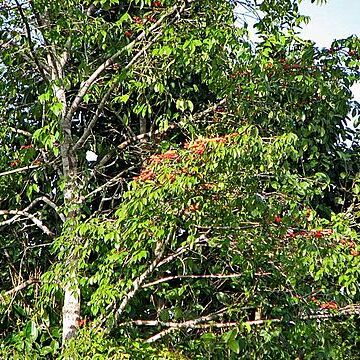Medium or large trees, rarely shrubs, with yellowish sap. Leaves opposite or subopposite, with numerous parallel lateral nerves running into a submarginal nerve; secretory canals not very visible. Flowers hermaphrodite, in sessile cymes, umbels or corymbs at the apices of short lateral branches or rarely solitary. Sepals 5, imbricate, persistent. Petals 5, contorted, deciduous. Disc cupuliform, ± 5-angled, persistent. Stamens joined into a tube surrounding the ovary, divided at the summit into groups of 2–6 anthers, deciduous. Ovary 5-locular, with 1–12 ovules in each locule; styles 5, joined at the base, then spreading-divergent at the apex, persistent. Berries with 1(–3) seeds. Seeds arillate with a thick entire embryo.
Androecium of 5 fascicles of stamens united to form a tube round the ovary and 5 united fasciclodes forming an annulus outside the stamen tube.
Leaves opposite, petiolate, entire, ± coriaceous, glabrous, with ± prominent venation, opaque or rarely with translucent glands.
Ovary 5-locular; loculi (1) few — ?-ovulate; styles 5, united below, spreading above; stigmas minute.
Inflorescence a terminal one-to many-flowered, corymbose or umbellate cyme.
Fruit a 1–3-seeded berry with tough epidermis.
Medium or large trees, rarely shrubs.
Seeds large, with a fibrous aril.
Petals 5, incurved at anthesis.
Flowers pedicellate, bisexual.
Sepals 5.

